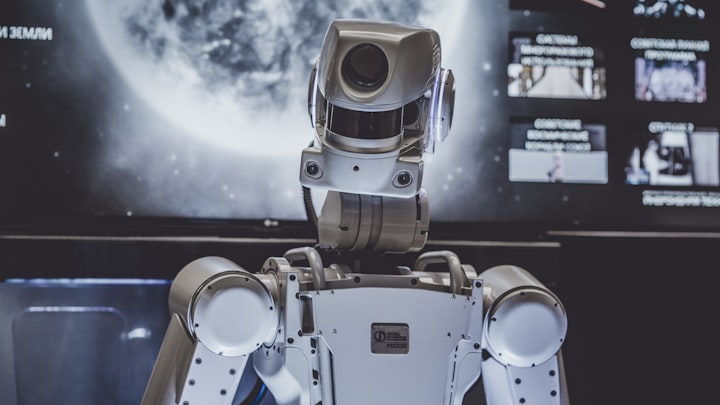AI vs Human Emotions
"They look sad, but they don't feel sad."

At some point in our lives, we tried to have casual conversations with our Google Assistant, Siri, Bixby, Alexa, etc. However, most of our questions went unanswered or, the answers were given in a somewhat ubiquitous way.
Generally, robots use AI to express themselves in the 'most humanly' way possible, based on the amount of data.
According to Dr. Eleanor Sandry --a professor at Curtin University:
"Robots are designed to sense the world around them so, they behave and act in accordance with it."
Scientists have already created robots that can express emotions. But without any underlying feelings or emotions; they are just facial articulations.

"They look sad, but they don't feel sad."
On the other hand, we as humans don't always act or feel in a universal way. We do have complications and choices that differ from each other.
In a sci-fi movie (Ex Machina), released in 2014, they exhibited this idea where a protagonist (Celeb Smith) is romantically attracted towards his invention of Artificial Intelligence (a female bot) and tried to escape with her from the area in which she was held captive.
Why does 'Emotional Artificial Intelligence' matter?
The concept of emotional artificial intelligence refers to the detection of human emotions to improve AI. It makes robots analyze not only cognitive but also the emotional aspects of human communication.
Emotional Artificial Intelligence goes by various names such as 'Affective Computing,' 'Human Centric Artificial Intelligence,' 'Social Artificial Intelligence,' etc. It is relatively a new concept and its technology is in the development phase.
Though it's not matured enough, it still can solve an immense number of problems.
But it can be misused in numerous ways, such as by hackers, social media platforms (for analyzing search terms and behavior), etc. Whether someone wishes to use it negatively or positively, it all depends on their personal goals.
The question is: How does it analyze human emotions/expressions?
The human face is a fascinating thing to study. It shows our attitudes, intentions, moods, etc. Sometimes it reflects who we are - even though each of us looks different, our faces typically function the same way.
According to the Facts.net:
There are 43 muscles that express facial emotions on the human face. Approximately 10,000 different facial expressions are possible in an individual.
As we know, Artificial Intelligence learns from its surroundings by observing various behaviors and patterns. It is the same concept, but we call it Automatic Sensing and Analyzing Human Behavior.
It explores human behaviors based on the environments around them. It captures emotions such as happiness, anger, tiredness, boredom, etc. It uses them to calculate results that can help them improve their emotional intelligence.
However, as we discussed, the technology is not mature enough. They face problems detecting small faces, rapidly changing faces, faces with big beards or mustaches, facial expressions of a running person, etc.
Applications of Emotional Artificial Intelligence:
Emotion AI still provides a lot of resources to the world and can be implemented in different ways. You might have seen videos over the internet about the companies that implemented robots to welcome others, deliver food, perform tasks for the company's customers or employees.
According to the research conducted by Gartner:
"By 2022, 10% of personal devices will have emotion AI capabilities."
- Combatting Medical Problems such as Autism (ASD) & Depression - According to Maja Pantic (Computer researcher and AI specialist):
"We can cure children who have Autism through the application of EAI and made them feel more connected to the human impressions. Similarly, severe problems like 'depression can be dealt with, to an extent with the help of EAI, by telling the conditions to the family members of the affected ones based on their facial expression and internet searches."
- In education - Emotion AI can be highly impactful for learning and solving problems. Suppose when we stumble upon a typical math or science problem that is difficult to solve, then EAI can detect our impressions and provide us an effortless method to solve it.

- Targeted Ads based on online customer behavior and interactions - Companies like Facebook, Google, other organizations, and startups use EAI to analyze their user's behavior and use the data to show them targeted ads on their platforms. They examine human behavior by observing their search patterns, the posts they share on social media, accessing their locations, their interest in specific products, etc.
According to research conducted by Affectiva - an emotion AI company:
"In our work with 70% of the largest advertisers in the world and 28% of Fortune Global 500 firms, we've found that emotionally resonant ads improve sales results."
- In the Automotive industry - Companies like Hyundai and Tesla have already introduced emotion-based intelligence in their vehicles. This technology can recognize the mood of drivers depending upon their facial expressions. For example, if the drivers feel frustrated or angry, the car provides them an easier route to reach their destination. If the driver feels a little giddy and dizzy, the car would automatically adjust the acceleration and balance.

- Smart Chatbots and Online Games - Smart chatbots can increase customer retention on one's website or product. They examine customer behaviors and depend upon their searches shows them the result they want. Similarly, in video games, bots can configure your skills and ability during gameplay and facial expressions to make the video game adapt to the changes you want.
According to the TechTarget - SearchEnterpriseAI:
The future of video games depends on the utilization and perfection of emotional AI, its ability to convey and reproduce realistic human emotions."
- For the Public Service - EAI is a helpful tool in the public service for judging people's moods and reactions. The happiness ministry of UAE implements EAI to examine the overall people's emotions towards the government in the country. In a company or an organization, the EAI-based surveillance camera can judge angry or frustrated customers and direct them to a well-trained professional. In a professional job interview, the credibility of potential and confident candidates judges by their facial expressions and reactions.
As this technology gets mature, we will see to what extent this will be beneficial for us.
Conclusion:
When it comes to reading and understanding emotions, we (as humans) are still way ahead of machines. It's observable that EAI can do wonders in its field of work, but comparing their emotions to human beings can be anything but not reality.
Humans have never imagined robots taking over the world. But now, the time has arrived, and we should accept that it can transform our lifestyle.
However, the technology can be misused and cause negative impacts. If used correctly, it tends to provide far good than its negative impacts.
According to Joelle Renstorm - a specialist in AI, robots:
"I find it equally comforting and terrifying to think of robots learning emotions through our experience!"
Let me know your thoughts in the comments. The subject is very diverse, and there could be thousands of words required to describe it completely. Thank you for reading this story and see you again.
References:
This time, with feeling: Robots with emotional intelligence are on the way. Are we ready for them?
How We Feel About Robots That Feel
A Puzzle About Emotional Robots
The future of AI in video games focuses on the human connection
Dyad X Machina: bringing emotion into machine learning (TensorFlow Meets)
About the Creator
Areeba Merriam
Research student | MS mathematics
Pursuing my research in the field of general relativity.
As a hobby I write blogs about popular science topics and biographies of scientists.






Comments
There are no comments for this story
Be the first to respond and start the conversation.